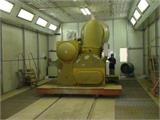Search Encyclopedia Paint Mist Purifier
Catalog of Paint Mist Purifier 12345
Commonly known as a spray booth, the process purpose of this equipment is to purify the over-spray mist during the painting process of workpieces as much as possible. The significance of the paint mist purifier is to achieve the purpose of internal and external environmental protection. It protects the physical and mental health of the operating employees and reduces public nuisances. The paint mist purifier is one of the essential equipment in the spray coating production line process. The paint mist purifier uses paint mist filtration material as the core component. The spray paint exhaust passes through multiple layers of gradually denser flame-retardant glass fiber material. The paint mist particles are intercepted, collided with, and absorbed by the material, accommodating them within the material and gradually weathering into powder form to achieve the purpose of purifying paint mist.
Currently, the coatings used in spraying are still mainly solvent-based. The organic solvents—benzene, toluene, xylene (referred to as 'three benzenes') on the surface of the paint film and in the paint mist directly volatilize into the workshop air. At the same time, the tiny paint mist droplets form dust after the solvent evaporates, which also disperses in the workshop air. The three benzenes belong to highly toxic solvents. When emitted into the workshop air during operations, workers inhale them through their respiratory system, which can cause acute and chronic poisoning, mainly damaging the central nervous system and hematopoietic system. Short-term inhalation of high concentration (1500mg/m³) benzene vapor can cause aplastic anemia; frequent inhalation of low concentration benzene vapor can also cause nausea, vomiting, confusion, and other neurological symptoms, with some cases leading to neurasthenia syndrome. Toluene has a stronger toxicity to the central nervous system than benzene but has less effect on the hematopoietic system. According to reports, long-term exposure to a benzene concentration of 188u375m²/h can produce obvious subjective symptoms. The chronic hazards of toluene are smaller than those of benzene, and symptoms may appear at concentrations between 43-1300m²/m³. When the three benzenes are mixed, they can irritate the eyes and nasal mucosa, and the neurological symptoms become more severe. As summarized above, the harm of paint mist to workers cannot be ignored. Under high pressure, paint is atomized into microparticles, but when sprayed by a spray gun, not all the paint reaches the spray surface. These paint particles form paint mist with the airflow. To improve the working environment for workers in the workshop and meet environmental protection requirements, it is necessary to treat the paint mist for compliant emission.
This equipment can be widely used in the purification treatment of low-concentration organic exhaust gas produced in industries such as petroleum, chemical, rubber, paints, coating, furniture, home appliances, and printing. The types of organic substances that can be treated include benzene compounds, ketones, esters, alcohols, ethers, and alkanes. This device consists of an oil mist absorption section, gas-liquid separation section, centrifugal separation section, high-efficiency filtration section, low-temperature plasma purification section, and activated carbon adsorption deodorization section. When the oil mist purification unit is in operation, the paint mist first enters the atomization absorption section. This section uses atomized waste engine oil to absorb the paint mist molecules, reducing the concentration of benzene-containing exhaust gases. After absorption, the paint mist exhaust gas then enters the gas-liquid separation section. In this section, the oil molecules and paint mist molecules contained in the paint mist are separated through inertial collision and turbulent collision in the gas-liquid separator. Then, under the high-speed rotation and centrifugal force of the fan impeller, the flow velocity and direction of the paint mist are continuously changed, causing the flowing paint mist to collide, compress, and coalesce on the impeller. The coagulated paint mist forms micro-particles and is thrown onto the inner wall of the box by centrifugal force, flowing out through the leak pipe. After centrifugal separation, most of the paint mist molecular particles are removed, and the escaped molecules enter the ultra-fine sponge filtration section again, using the large specific surface area of the ultra-fine sponge to strongly retain oil and paint mist molecules. After being purified by the first four stages, the paint mist molecules and oil mist molecules have their particle molecules basically removed. They then enter the plasma purification zone and deodorization zone, where micron and submicron-level molecules are degraded, sterilized, disinfected, and deodorized before emitting completely clean air.
1. No water required, environmentally friendly and energy-saving;
2. High efficiency in paint mist purification, with a purification efficiency reaching 90-99%;
3. Low equipment running resistance and low energy consumption;
4. Simple equipment structure, convenient maintenance and repair;
5. High purification efficiency, large dust capacity, flame retardancy, low resistance, and long service life of paint mist filtration materials.
I will evaluate: Entry Evaluation: 1 point (evaluated by 7 people).



